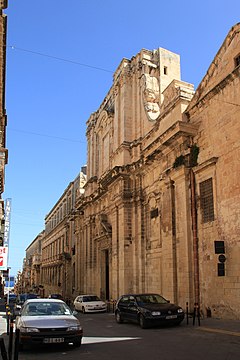
Valletta is the capital city of Malta and one of its 68 council areas. Located between the Grand Harbour to the east and Marsamxett Harbour to the west, its population as of 2021 was 5,157. As Malta’s capital city, it is a commercial centre for shopping, bars, dining, and café life. It is also the southernmost capital of Europe, and at just 0.61 square kilometres (0.24 sq mi), it is the European Union's smallest capital city.
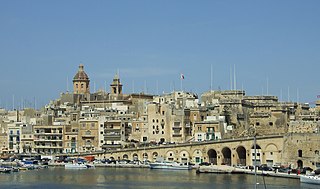
Birgu, also known by its title Città Vittoriosa, is an old fortified city on the south side of the Grand Harbour in the South Eastern Region of Malta. The city occupies a promontory of land with Fort Saint Angelo at its head and the city of Cospicua at its base. Birgu is ideally situated for safe anchorage, and over time it has developed a very long history with maritime, mercantile and military activities.
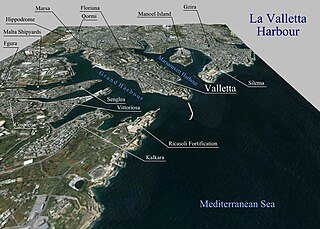
The Grand Harbour, also known as the Port of Valletta, is a natural harbour on the island of Malta. It has been substantially modified over the years with extensive docks, wharves, and fortifications.
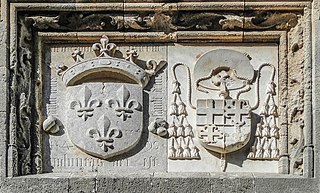
A langue or tongue was an administrative division of the Knights Hospitaller between 1319 and 1798. The term referred to a rough ethno-linguistic division of the geographical distribution of the Order's members and possessions. Each langue was subdivided into Priories or Grand Priories, Bailiwicks and Commanderies. Each langue had an auberge as its headquarters, some of which still survive in Rhodes, Birgu and Valletta.
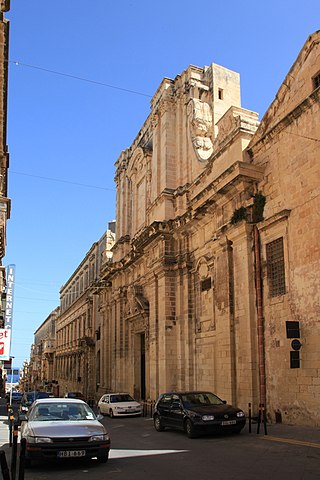
The Church of the Circumcision of Our Lord, also known as the Church of the Jesuits or the Church of the University, is one of the oldest and largest churches in Valletta, Malta. It was originally built between 1593 and 1609 by the Jesuit order, and it is located adjacent to the Old University Building, which originally housed a Jesuit college known as the Collegium Melitense. The church was rebuilt in the Baroque style by Francesco Buonamici after suffering extensive damage in an explosion in 1634. The church remained in use after the Jesuits were expelled from Malta in 1768, and it is also used for Masters and Doctoral graduation ceremonies of the University of Malta, the successor to the Collegium.

The Inquisitor's Palace, also known as the Sacred Palace, is a palace in Birgu, Malta. It was the seat of the Maltese Inquisition from 1574 to 1798, under the name Palazzo del Sant'Officio. The building was originally constructed as a courthouse known as the Castellania in the early 16th century, but little remains of the original building due to major alterations and renovations carried out in the subsequent centuries.

The Collegium Melitense was a Jesuit college in Valletta, Hospitaller Malta, which existed between 1592 and 1769. Lectures at the educational institution began in 1593, and it moved to a purpose-built building adjacent to a Jesuit church in 1597. The 17th century saw an expansion of its curriculum and an increase in the number of students in the college, and in 1727 it was recognised as a university and subsequently it also became known as the Academia Parthenia. After the Jesuits were suppressed from Malta, the college was reorganised into the Pubblica Università di Studi Generali, which was established on 22 November 1769. The latter is now known as the University of Malta.

Hospitaller Malta, known in Maltese history as the Knights' Period, was a de facto state which existed between 1530 and 1798 when the Mediterranean islands of Malta and Gozo were ruled by the Order of St. John of Jerusalem. It was formally a vassal state of the Kingdom of Sicily, and it came into being when Emperor Charles V granted the islands as well as the city of Tripoli in modern Libya to the Order, following the latter's loss of Rhodes in 1522. Hospitaller Tripoli was lost to the Ottoman Empire in 1551, but an Ottoman attempt to take Malta in 1565 failed.

The Auberge d'Italie was an auberge in Birgu, Malta. It was built in the sixteenth century to house knights of the Order of Saint John from the langue of Italy.

Auberge d'Angleterre is an auberge in Birgu, Malta. It was built in around 1534 to house knights of the Order of Saint John from the langue of England. It now houses a health centre, and it is the best-preserved Hospitaller auberge in Birgu.

Auberge de France is an auberge in Birgu, Malta. It was built in around 1533 to house knights of the Order of Saint John from the langue of France, which induced the entire Kingdom of France except for Auvergne and Provence which were separate langues. The building housed the French langue until a new Auberge de France was opened in Valletta.

The fortifications of Malta consist of a number of walled cities, citadels, forts, towers, batteries, redoubts, entrenchments and pillboxes. The fortifications were built over hundreds of years, from around 1450 BC to the mid-20th century, and they are a result of the Maltese islands' strategic position and natural harbours, which have made them very desirable for various powers.

The fortifications of Valletta are a series of defensive walls and other fortifications which surround Valletta, the capital city of Malta. The first fortification to be built was Fort Saint Elmo in 1552, but the fortifications of the city proper began to be built in 1566 when it was founded by Grand Master Jean de Valette. Modifications were made throughout the following centuries, with the last major addition being Fort Lascaris which was completed in 1856. Most of the fortifications remain largely intact today.
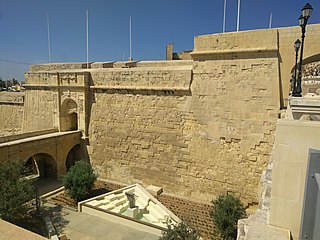
The fortifications of Birgu are a series of defensive walls and other fortifications which surround the city of Birgu, Malta. The first fortification to be built was Fort Saint Angelo in the Middle Ages, and the majority of the fortifications were built between the 16th and 18th centuries by the Order of Saint John. Most of the fortifications remain largely intact today.

The Birgu Clock Tower, also called the Vittoriosa Clock Tower and originally the Civic Clock Tower, was a clock tower in Birgu, Malta. It was located in Victory Square, the city's main square, and it was a prominent landmark in Birgu and the rest of the Three Cities. The tower was probably built in the Middle Ages, although some sources state that it was constructed in 1549. It served as a watchtower since it had views over the Grand Harbour and the surrounding countryside, and it saw use during the Great Siege of Malta in 1565. A clock was installed in the tower in the 17th century.

The Slaves' Prison officially known as the Grand Prison and colloquially as the bagnio, was a prison in Valletta, Malta. It was established in the late 16th century, and remained in use as a prison throughout the 17th and 18th centuries. It was subsequently used as a naval hospital, a school and an examination hall. It was bombed in World War II, and the ruins were demolished to make way for a block of flats.

On 18 July 1806, approximately 40,000 lb (18,000 kg) of gunpowder stored in a magazine (polverista) in Birgu, Malta, accidentally detonated. The explosion killed approximately 200 people, including British and Maltese military personnel, and Maltese civilians from Birgu. Parts of the city's fortifications, some naval stores, and many houses were destroyed. The accident was found to be the result of negligence while transferring shells from the magazine.

The Old University Building, also known as the Valletta Campus, is the original campus of the University of Malta, located adjacent to the Church of the Jesuits in Valletta, Malta. Construction of the building began in 1595, and it originally housed a Jesuit college known as the Collegium Melitense Societatis Jesu. The building had to be repaired after being damaged in an explosion in 1634 and an earthquake in 1693.
Francesco Buonamici (1596–1677) was an Italian Baroque architect, painter and engraver who was active in Lucca, Malta, Sicily and Rome during the 17th century. He played a significant role in the introduction of Baroque in Malta.

The Bishop's Palace is a palatial building in Birgu, Malta which was a residence of the Roman Catholic Bishops of Malta. It was constructed in the 16th century.
